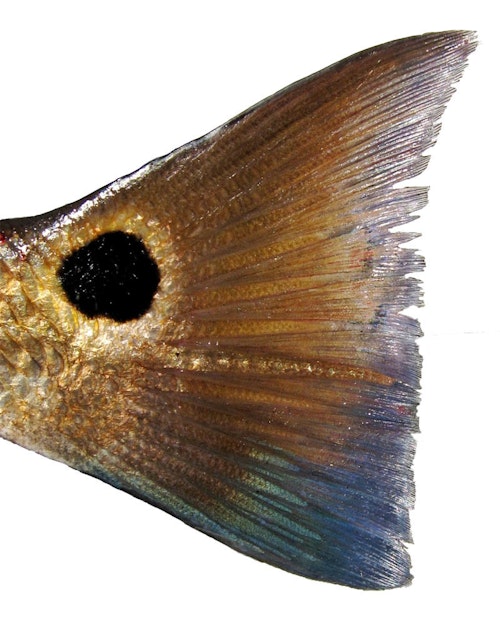Some redfish can live up to 40 years, which explains how one redfish was caught at least twice — 21 years apart.
The first time, this redfish was near Georgetown, South Carolina, where it was caught and tagged. According to the Post and Courier, the daily newspaper serving nearby Charleston, the “finger-length nylon tags each have a different number for identifying individual fish — proof it was part of the state’s research pool. The tags provide DNR with a wealth of information on the reds and other coastal species it follows.”
As this catching, tagging and re-catching incident might suggest, redfish can live for decades, and some grow to be quite hefty. Mature redfish, also called bull reds, can be massive. Louisiana's record was a 61-pounder caught by David Weber south of Cocodrie in June 1992. The world-record, a 94-pounder, was caught on Hatteras Island, North Carolina, in 1984.
Redfish, or red drum, thrive in temperate water. They’re found in the Atlantic Ocean from Massachusetts to Florida and in the Gulf from Florida to Northern Mexico.
If you’re new to fishing for reds or maybe you've recently realized it's time to revisit the fundamentals (this can often happen after being on the water in the fall spawning season and coming up grossly short), we’ve curated a handful of facts that serve as a quick and dirty redfish primer.

Appearance
- Body is copper-bronze, fading to a lighter belly
- One or more dark, ocellated spots at base of tail (occasionally without spot)
- Lack barbels on lower jaw
- Large scales
- Powerful pharyngeal teeth used to crush oysters and other shellfish
- Similar Species: Black drum, P. cromis (has chin barbels and lacks spot on tail)
- Size: Up to 61 inches
Redfish Range
Coastal waters. In winter, redfish are found in seagrass, over muddy or sand bottoms, or near oyster bars or spring fed creeks. Red drum naturally occur along the eastern and southern Atlantic and Gulf of Mexico coasts of Louisiana, Texas, Alabama, Mississippi, Florida, Georgia, the Carolinas and Virginia.
Behavior and Spawning
Juvenile redfish are an inshore species until they reach roughly 30 inches (4 years). They then migrate to the nearshore population.
Prodigious spawners that produce tens of millions of eggs. Spawning season is from about August through December, in passes, inlets and lagoon estuaries around the state. During spawning season, redfish use special muscles rubbing against their air bladder to produce a "drumming" sound for which they are named.
Diet
Feed on fishes and invertebrates.
Basic Redfish Baits and Lures
Floating a live shrimp under a popping cork is a good way to fish for redfish. They also chase crabs, mullet, pinfish and killifish (mud minnows). Casting soft-bodied jigs, spoons and even top-water plugs will catch the attention of these powerful estuarine musicians.

So About the Spot
Redfish have one or more spots. What's the spot for? How many can a fish have? Do some redfish have no spots? Our friends at Cape Coral Daily Breeze provide these answers:
Biologists believe reds develop black spots, usually one on each side near the tail, as camouflage. The idea is to make a predator think its tail is really its head. It's easier to heal a tail wound, then a head-on-attack wound.
The predator fish typically is aiming for the head, zeroing in on the "eye," but in this case the spot. The norm for spotting is one spot on each side of the tail, but variations are countless. Some have spots evenly balanced from side to side while others bear completely different markings from port to starboard. Spots can range past a redfish's tail, occasionally stretching up to its gills.
Most spots occur separately, but connected dots occasionally create unique patterns. Usually, the fish absorb the pigmentation, losing the spot, by the time they become adult breeders at 10 pounds or so. Generally, a red can live 30 to 40 years.
Theories about redfish spots and numbers range from salinity levels to geographical locations. Biologist Gina Russo, the program coordinator for the past Project Tampa Bay, a hatchery project, believes it's as simple as random selection by nature.
Although rare, some redfish are caught with no spots. All reds begin life this way, but those whose destiny is to have freckles will develop their lifetime pattern by their fourth or fifth month.
Culinary Profile
Redfish have a mild, sweet flavor with firm flesh and large, moist flakes. It is comparable to Red Snapper. Very fresh Red Drum Fish have an emerald green tint to the raw flesh, while larger fresh Red Drum Fish have a red tint. The flesh of both species cooks up to pure white.
The smaller fish of this species tends to be sweeter and flakier.






